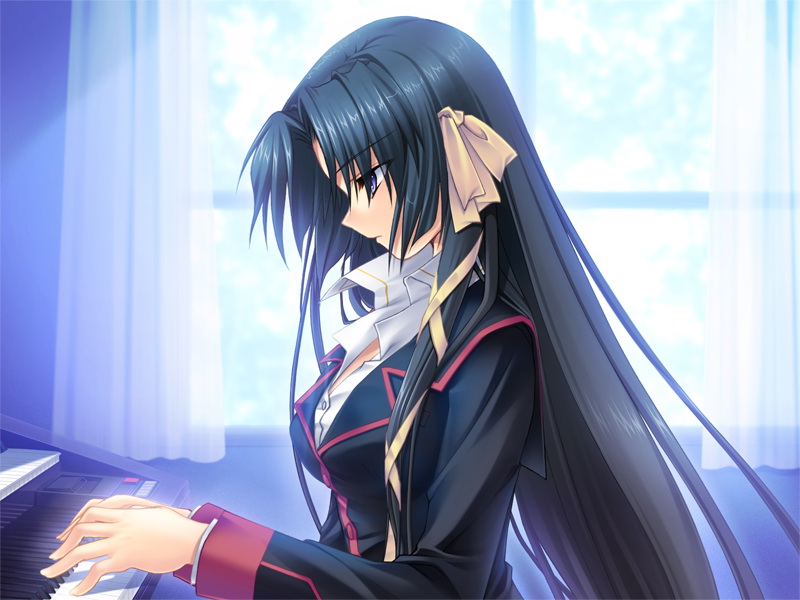Disclaimer: I’m actually just a novice-level pleb who could barely play some of Amadeus Mozart’s minuets, so I can only really help out with beginner-level stuff. I actually just want to talk about the piano at the moment, and perhaps get people into this wonderful instrument, but part of the reason why I wanted to start this thread is because I personally want to learn as well from those who can play better than me. Ahaha. I hope this thread will turn out helpful. :'D
Piano crash course by yours truly
So, if you’re interested in learning how to play the piano, and don’t know where or how to start, here are some first few steps into getting into the piano.~
Part 1: Looking for the right keyboard
As you look for one, chances are you’ll stumble with any of these:
• grand piano
• upright piano
• electronic keyboard
• digital piano
• electronic organ
• church organ (okay I’m just kidding a bit on this one)
Whichever instrument you choose will depend on what you want to be as a keyboardist. If you’re looking to be a band member or choir accompanist (or something like that musician who did that really cool Tori no Uta cover), perhaps the flexibility of the electronic keyboard or organ when it comes to instrumentation will suit you better. Since we’re talking specifically about piano (as in the kind of musical instrument that Frederic Chopin is known to have focused on), we’re going to focus on the keyboard suitable for piano playing.
Ideally, and if you reaaaaallllyyyy seek to be an expert, you’ll want to get either the grand, upright, or digital piano. A lot of their differences have to do with their control. This is a good discussion about their differences. (If you’re wondering about weighted action, it’s that piano keys are supposed to be quite heavy.) Overall, they’re pretty neat long-term investment.
But if you’re pretty broke or still starting out, I think an electronic keyboard is fine. The number of keys vary though, some have 88 (full set), some have 61 (5-octave), and others have it even fewer. The latter two are either synthesizers or for children. Having the full set of keys is definitely ideal. 5 octaves is actually just fine, but your repertoire will be severely limited: Romantic Period piano pieces are known to make full use of the piano’s range, and even most pop music arrangements reaches bass notes that a 5-octave keyboard doesn’t have. I know, because that’s the kind of keyboard I have. ;-; (I still love you though, this keyboard of mine)
In any case, if you’re going for an electronic keyboard, you’ll certainly want to make sure it has the following specifications at the very minimum:
• touch response
• can at least be equipped with a sustain pedal
This is because control of dynamics and use of damper pedal are extremely important skills to learn even as a beginner. Speaking of skills:
Part 2: Basic skills
You need to know how to read sheet music. At least know where the middle C is in the G clef, the F clef, and on the keyboard itself, and you’ll be fine. :'D
Moving on. There are many ways you can learn the piano. Actually, learning through video tutorials or Synthesia is just fine. Really. But if you want to gain necessary skills to be a well-rounded pianist, you’ll want to learn how to play pieces from books. For that, try looking for graded piano course books. I personally started with the Leila Fletcher books, but the Thompson books (which I’ve already seen before) seem really popular.

The benefit to these books is that they will guide you step-by-step to each skill necessary to be able to perform more difficult pieces. (These books will also teach you how to read sheets along the way.) Some of these skills include:
- hand (particularly the curving of the fingers) and body posture
- finger position/finger numbers/fingering (don’ttakethisoutofcontextpls)
- basic music theories like tempo, time signature, key signatures etc.
- arpeggios
- arpeggiated chords
- grace notes
- damper pedal
- octaves
The only disadvantage, perhaps, is that a lot of the pieces here are really meant for children and for the most part, really boring. It can potentially kill any motivation to learn more, but trying to start with learning important skills first has big payoff. I mean it’s also disheartening to try playing catchy but deceptively simple Romantic Period pieces like Grande Valse Brillante or Liebestraum only to realize that they’re difficult as hell, but by learning pieces step by step, you might be able to get there. But it’s going to take a long while. Learning piano takes quite a lot of patience~
But of course learning the piano shouldn’t always be boring. I mean it’s going to be inevitably frustrating, but you’ll probably want to learn a piece that you actually enjoy. So here are some recommended pieces that are graded!~ (Note: I can’t talk about pop music arrangements because it’s pretty hard to find easy ones that sounds good anyway. :'D)
Part 3.1: Classical Music
I kept mentioning about Romantic Period, so I’ll explain first. Classical Music loosely refers to European music created from the following periods (ranked from earliest to latest, along with some known figures of that time):
-
Baroque - emphasized complex melodies
** Johann Sebastian Bach (Brandenburg Concertos, Toccata and Fugue)
** Antonio Vivaldi (The Four Seasons Concertos~)
** George Frideric Handel (Water Music) -
Classical - focused on simplicity and entertainment
** Joseph Haydn (Surprise!)
** Wolfgang Amadeus Mozart (Eine Kleine Nachtmusik, Rondo Alla Turca)
** Ludwig Van Beethoven (Fur Elise, Ode to Joy) -
Romantic - incorporated expression and emotion to music
** Pyotr Tchaikovsky (ballet suites e.g. Swan Lake, The Nutcracker)
** Frederic Chopin (Nocturne Op. 9-2, Grande Valse Brillante)
** Franz Liszt (Hungarian Rhapsodies, Liebestraums)
Well anyway, I found a really neat collection of classical pieces that is also completely free: https://archive.org/details/Altoonsanthclasspian
It’s easy to find sheet music of classical pieces, anyway, but the good thing is that these are graded, so it’s easy to know where to start. In May is especially accessible even to complete beginners. There are a few caveats in this collection though:
(1) There are no finger numbers - numbers ranging from 1-5, where the thumb is 1 and the pinky is 5, that is assigned to notes in the score to indicate which fingers to use. They’re very helpful especially when you’re still starting out. If you feel the need to, you can look for other sheet music of the pieces here that have finger numbers.
(2) Minute Waltz iS NOT A NOVICE-LEVEL PIECE. ESPECIALLY WHEN FUR ELISE IS PUT UNDER INTERMEDIATE LEVEL. Like I know Minute Waltz is one of the easier Chopin pieces and I think it’s even easier than his Nocturne Op 9-2, but NO DON’T; CHOPIN IS NEVER EASY LIKE MINUTE WALTZ SHOULD BE INTERMEDIATE-LEVEL BY THIS BOOK’S STANDARDS. That’s all.
Part 3.2: Key OSTs
(as a Key Fan ofc)
I’ve tried a few Key OSTs before, and so far I think the most accessible piece for beginners would be the original piano section of Shionari? I’ll try sharing the arrangement I’ve been playing for it, with finger numbers for those who want to try.  I heard Sora ni Hikaru is pretty accessible as well.
I heard Sora ni Hikaru is pretty accessible as well.
Ushio is surprisingly simple despite its difficult key signature. Nirinsou is quite simple as well, but not as accessible to beginners because of its arpeggiated chords and octaves.
Part 4: Notes 
- The guide I made here is for those who want to start with self-studying, because trying to find reliable resources for self-study isn’t quite easy. But if you’re dead serious about becoming a pianist, specifically a stage performer, in the future, you’ll definitely want to invest in piano lessons (and college education).
- I forgot about learning scales, which I think is extremely important! Playing the C major scale is the first thing I formally learned and is always the first thing I teach to those who approach me for a brief lesson. I often play it for warm-ups and refreshers. (I also like using scales to brief myself to the key signature of pieces I’m going to play). Playing the scale with both hands with proper fingering is a good beginner training for left-right hand independence. :'D This is a nice video guide for the scale playing.
- A lot of instructors recommend a lot of keyboard exercise every start of practice. I can’t say too much about that, but I did hear from somewhere that Hanon exercises aren’t particularly productive use of practice time. Maybe someone else have insights on this?
- As much as possible, make it a habit to practice regularly (unless you’re like me who rarely have access to piano, and for that I feel you ;u; ). It doesn’t have to be daily; one hour a day, three times a week is fine.
Okay end of this stupidly long post. Haha. I’d love to hear suggestions on whatever stuff I wrote here, or anything more about learning this beautiful instrument. ^^







